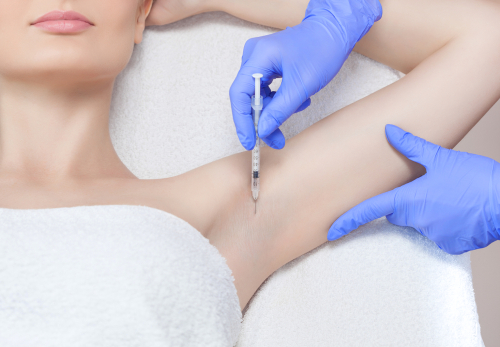 To diagnose this condition, a dermatologist gives the patient a physical exam. This includes looking closely at the areas of the body that sweat excessively. A dermatologist also asks very specific questions. This helps the doctor understand why the patient has excessive sweating.
To diagnose this condition, a dermatologist gives the patient a physical exam. This includes looking closely at the areas of the body that sweat excessively. A dermatologist also asks very specific questions. This helps the doctor understand why the patient has excessive sweating.
Sometimes medical testing is necessary. Some patients require a test called the sweat test. This involves coating some of their skin with a powder that turns purple when the skin gets wet.
To find an underlying medical condition, other medical tests may be necessary.
How do dermatologists treat hyperhidrosis?
Treatment depends on the type of hyperhidrosis and where the excessive sweating occurs on the body. Your dermatologist also considers your overall health and other factors.
Treatments that dermatologists use to help their patients control hyperhidrosis include:
Antiperspirants
This may be the first treatment that a dermatologist recommends. It is affordable. When applied as directed, an antiperspirant can be effective. Your dermatologist may recommend a regular or clinical-strength antiperspirant. Some patients need a stronger antiperspirant and receive a prescription for one.
Uses: Apply to underarms, hands, feet, or hairline
How it works: The antiperspirant sits on top of your skin. As you sweat, the antiperspirant is pulled into your sweat glands. This plugs the sweat glands. When your body senses that its sweat glands are plugged, this should signal your body to stop producing so much sweat.
Side effects: Where they apply the antiperspirant, some people develop:
Botox Toxin Injections
Dr. Binhlam can inject a weak form of this medicine into your underarms. To treat excessive sweating, a patient will need to have very tiny amounts injected in many areas of the underarms. When performed properly, patients have little pain or discomfort.
Uses: Underarms
The U.S. Food and Drug Administration (FDA) has approved this treatment for the underarms. Findings from some research studies suggest that this treatment may be effective for other areas of the body. It may help post-menopausal women who sweat excessively on the head. It may be effective for excessive sweating that affects the hands and feet.
How it works: The injections temporary block a chemical in the body that stimulates the sweat glands. Most patients notice results 4 to 5 days after receiving treatment.
Reduced sweating lasts about 4 to 6 months — and sometimes longer. When the excessive sweating returns, you can be retreated.
- Burning sensation
- Irritated skin
